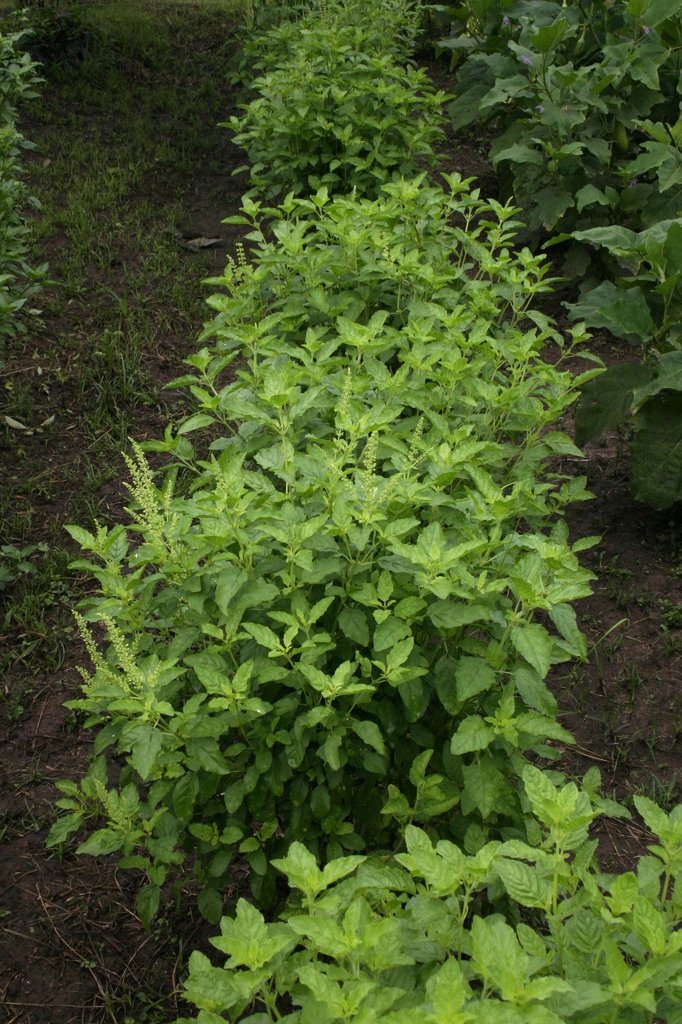 Image 1 of 3
Image 1 of 3

 Image 2 of 3
Image 2 of 3

 Image 3 of 3
Image 3 of 3




Holy Basil "Rama" Ocimum Tenuiflorum Plant
TULSI BASIL RAMA Ocimum tenuiflorum (holy or sacred basil) 8 week 3.5” deep pot transplant.
Tulsi (Ocimum tenuiflorum), often referred to as “The Queen of Herbs” is widely regarded as a valuable medicinal herb with some culinary use.
Rama Tulsi Basil has shiny green leaves on a green stem that continue to produce all season long until frost. As it flowers, clip back the flowers, and the plant will send out new leaves and flowers. The leaves and flowers can be used as a beautiful soothing medicinal tea. Tulsi has been used for 3,000 years in ayurvedic medicine, “the knowledge for long life”. Tulsi calms the nerves, while nourishing the heart. It’s also used for colds, headaches, stomach disorders, inflammation, arthritis, heart disease, stress, cancer and antibacterial skin preparations. It’s an excellent herbal tea on its own or blended with other herbs. Also known as Holy Basil and Ocimum sanctum.
Tulsi basil originated in India as an aromatic perennial shrub, medicinal or culinary herb tea and oils. The aroma is spicy and complex, similar to clove. Four common varieties: Rama Tulsi is hardy, easy to grow and our favorite for a soothing tea. Vana Tulsi has slightly fuzzy leaves, is a larger plant and is closer to the wild form. Tulsi Kapoor has shiny green leaves, best for culinary uses, smaller plant. Tulsi Krishna has purple leaves, slightly more difficult to germinate.
TULSI BASIL RAMA Ocimum tenuiflorum (holy or sacred basil) 8 week 3.5” deep pot transplant.
Tulsi (Ocimum tenuiflorum), often referred to as “The Queen of Herbs” is widely regarded as a valuable medicinal herb with some culinary use.
Rama Tulsi Basil has shiny green leaves on a green stem that continue to produce all season long until frost. As it flowers, clip back the flowers, and the plant will send out new leaves and flowers. The leaves and flowers can be used as a beautiful soothing medicinal tea. Tulsi has been used for 3,000 years in ayurvedic medicine, “the knowledge for long life”. Tulsi calms the nerves, while nourishing the heart. It’s also used for colds, headaches, stomach disorders, inflammation, arthritis, heart disease, stress, cancer and antibacterial skin preparations. It’s an excellent herbal tea on its own or blended with other herbs. Also known as Holy Basil and Ocimum sanctum.
Tulsi basil originated in India as an aromatic perennial shrub, medicinal or culinary herb tea and oils. The aroma is spicy and complex, similar to clove. Four common varieties: Rama Tulsi is hardy, easy to grow and our favorite for a soothing tea. Vana Tulsi has slightly fuzzy leaves, is a larger plant and is closer to the wild form. Tulsi Kapoor has shiny green leaves, best for culinary uses, smaller plant. Tulsi Krishna has purple leaves, slightly more difficult to germinate.
TULSI BASIL RAMA Ocimum tenuiflorum (holy or sacred basil) 8 week 3.5” deep pot transplant.
Tulsi (Ocimum tenuiflorum), often referred to as “The Queen of Herbs” is widely regarded as a valuable medicinal herb with some culinary use.
Rama Tulsi Basil has shiny green leaves on a green stem that continue to produce all season long until frost. As it flowers, clip back the flowers, and the plant will send out new leaves and flowers. The leaves and flowers can be used as a beautiful soothing medicinal tea. Tulsi has been used for 3,000 years in ayurvedic medicine, “the knowledge for long life”. Tulsi calms the nerves, while nourishing the heart. It’s also used for colds, headaches, stomach disorders, inflammation, arthritis, heart disease, stress, cancer and antibacterial skin preparations. It’s an excellent herbal tea on its own or blended with other herbs. Also known as Holy Basil and Ocimum sanctum.
Tulsi basil originated in India as an aromatic perennial shrub, medicinal or culinary herb tea and oils. The aroma is spicy and complex, similar to clove. Four common varieties: Rama Tulsi is hardy, easy to grow and our favorite for a soothing tea. Vana Tulsi has slightly fuzzy leaves, is a larger plant and is closer to the wild form. Tulsi Kapoor has shiny green leaves, best for culinary uses, smaller plant. Tulsi Krishna has purple leaves, slightly more difficult to germinate.